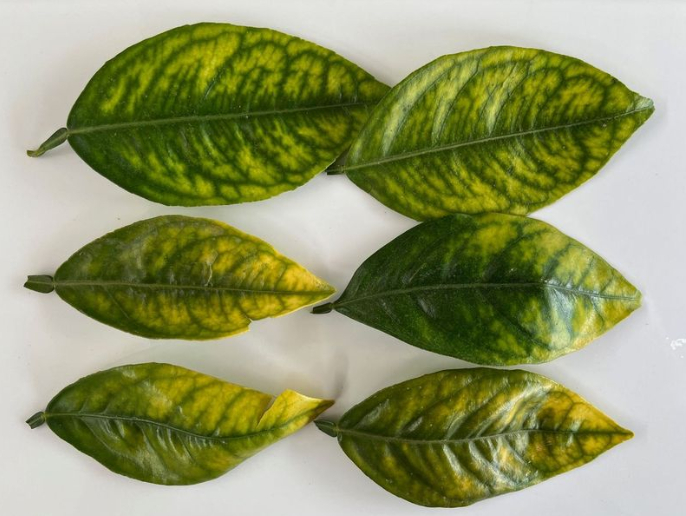Deficiencies of iron (Fe), zinc (Zn), manganese (Mn), and magnesium (Mg) are common in plants grown on calcareous soils, which contain calcium carbonate. These nutrient deficiencies manifest as interveinal chlorosis: the veins of the leaves have a normal green hue, while the leaf tissue between the veins is light green or even yellow.
Since iron, zinc, and manganese are immobile within the plant, deficiency symptoms appear first in young leaves. Iron deficiency is the most common and is also called "iron chlorosis" (photo 1). In contrast, magnesium (a macronutrient) is mobile within the plant, and deficiency symptoms first appear on older leaves (photo 1).
Depending on the severity of the deficiency, these nutrient deficiencies can reduce yield and fruit size. Severe deficiency can lead to the drying of shoots and even the death of the tree. Visual deficiency symptoms are similar for iron, zinc, and manganese. In addition, simultaneous deficiencies are common, making visual diagnosis of these micronutrient deficiencies unreliable.
Even the chemical analysis of leaf nutrient content presents some difficulties. First, only a fraction of the iron present in the plant is physiologically active. Ferrous iron (Fe+2) is considered active in the plant, unlike ferric iron (Fe+3).
 Image 1: Visual symptoms of magnesium deficiency in older orange leaves.
Image 1: Visual symptoms of magnesium deficiency in older orange leaves.
The total iron in the plant includes both forms of the element. Therefore, the total iron content in the leaves, which is commonly analyzed in agricultural laboratories, is not a valid index for determining the nutritional level of iron in crops, unlike the total content of other elements.
The total iron content in chlorotic leaves may be similar or even higher than in green leaves, highlighting that total iron is not a useful variable for diagnosing iron deficiency in crops. However, diagnostic standards based on total iron are indicated in the literature. The active iron content in leaves is better correlated with chlorophyll content, but this analysis is complex and is not routinely performed in agricultural laboratories.
Another difficulty concerns the applicability of diagnostic standards. On several occasions in Chile, the zinc content in healthy leaves was found to be below the normal zinc standards for the crop in question. It should be noted that these standards come from scientific research conducted in other countries and are apparently not applicable in Chile, so national studies are needed.
Possible solutions
Applying sulfates of iron, zinc, manganese, and magnesium to the soil is often ineffective in correcting these nutrient deficiencies in plants grown on calcareous soils. These soils are alkaline, causing low solubility of iron, zinc, manganese, and magnesium in the soil, explaining the ineffectiveness of their application as sulfates.
Various synthetic chelates of these nutrients are available for foliar or soil application. Chelates of these nutrients are effective in correcting deficiency problems in crops, but their cost is high and may reduce the economic profitability of the farm.
The use of acids (sulfuric or phosphoric) is usually of low effectiveness in calcareous soils because the acid reacts with the calcium carbonate present in the soil and neutralizes it. A simple calculation can show that impractical amounts of acid would be required to dissolve all the calcium carbonate in the soil.
It is worth noting that in central Chile, calcareous soils are of lacustrine origin. Lacustrine deposits form over thousands of years as sediments accumulate at the bottom of lakes, which may dry up over time, giving rise to lacustrine soils. In central Chile, calcareous soils of lacustrine origin are rare.
Therefore, the best solution is to avoid purchasing or leasing land with calcareous soils. The presence of calcium carbonate in the soil can be easily detected by applying an acid. If calcium carbonate is present in the soil, effervescence will occur.
On the other hand, calcareous soils are common in northern Chile. In this case, the best solution is to choose suitable crops. It is important to note that many soils in the Mediterranean region and arid areas of Asia are calcareous. Therefore, the plant species from these regions are adapted to the presence of calcium carbonate in the soil. Examples of such crops are the fig, pomegranate, olive, vine, and others.
Citrus plants, on the other hand, originate from tropical and subtropical regions of Asia, while the avocado is native to Mexico and Central America. The soils in these rainy regions are characterized by acidity. In contrast, calcareous soils are alkaline (with a pH close to 8.0). Therefore, growing citrus and avocado on calcareous soils is like swimming against the current.
In an attempt to do so, it is highly likely that iron, zinc, manganese, and magnesium deficiencies will occur, which can reduce crop development and the economic profitability of the farm. The same applies to horticultural crops from regions with acidic soils, such as tomatoes.
It is important to remember that grasses also adapt to calcareous soils. In the particular case of iron, grasses are able to effectively sequester this nutrient by releasing phytosiderophores from their roots into the surrounding soil. Therefore, grasses are another possible species to cultivate in calcareous soils.
Finally, it is important to remember that iron, zinc, manganese, and magnesium deficiencies in plants can also occur in non-calcareous soils, in the case of irrigation with water high in bicarbonate ions. A water pH above 7.5 indicates the presence of bicarbonate ions, which induce physiological disturbances in crops that hinder the efficient absorption of nutrients by the plant and their transport within the plant.
Therefore, it is useful to acidify irrigation water to reduce the concentration of bicarbonate ions. The recommended pH for irrigation water is 5.5, and drastic acidification to lower pH values should be avoided. However, acidifying irrigation water is not recommended in water with high electrical conductivity because adding acid will further increase the salt content, which can be harmful to crop development.
Source: Mundoagro
Images: Mundoagro
Cherry Times - All rights reserved













